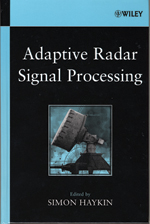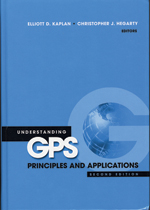Adaptive Radar Signal Processing
Simon Haykin, Editor
Wiley Interscience • 243 pages; $94.95
ISBN: 978-0-471-73582-3
 This book focuses on two types of radar: Surveillance radar, the purpose of which is target detection in the presence of unwanted signals, interference and noise; and low tracking radar, which is complicated by multipath caused by reflections from the sea/ocean surface. The book is organized in two parts. Part I, consisting of two chapters, deals with radar spectrum analysis. Chapter 2 addresses the low-angle tracking radar problem. With estimation of the target’s angle of arrival in the presence of the multipath issue of interference, a spectrum estimation procedure known as the multi-taper method or multiple-window method is used. Chapter 3 also uses the multi-taper method, but with an important extension. Specifically, the power spectrum is now estimated as a function of both time and frequency. Part II, consisting of Chapters 4 to 6, deals with dynamic models of radar returns produced in a marine environment. Chapter 4 focuses on modeling the underlying dynamics responsible for the generation of sea clutter. Three specific approaches are discussed: chaos, hybrid amplitude modulation-frequency modulation and the auto-regressive model.
This book focuses on two types of radar: Surveillance radar, the purpose of which is target detection in the presence of unwanted signals, interference and noise; and low tracking radar, which is complicated by multipath caused by reflections from the sea/ocean surface. The book is organized in two parts. Part I, consisting of two chapters, deals with radar spectrum analysis. Chapter 2 addresses the low-angle tracking radar problem. With estimation of the target’s angle of arrival in the presence of the multipath issue of interference, a spectrum estimation procedure known as the multi-taper method or multiple-window method is used. Chapter 3 also uses the multi-taper method, but with an important extension. Specifically, the power spectrum is now estimated as a function of both time and frequency. Part II, consisting of Chapters 4 to 6, deals with dynamic models of radar returns produced in a marine environment. Chapter 4 focuses on modeling the underlying dynamics responsible for the generation of sea clutter. Three specific approaches are discussed: chaos, hybrid amplitude modulation-frequency modulation and the auto-regressive model.
Chapter 5 expands on the ideas described on modulation theory in Chapter 4 and further refines this physical basis for the statistical characterization of sea clutter dynamics by accounting for nonstationarity. Chapter 6 completes the discussion on the dynamic of radar returns in a marine environment by formulating a Bayesian framework for detection-through-tracking of a target moving on the sea surface in the presence of sea clutter. As with Part I, the adaptive signal-processing theory presented in all three chapters of Part II is supported experimentally using real life radar data collected using the IPIX radar under different environmental conditions.
To order this book, contact:
John Wiley & Sons Inc.
One Wiley Drive
Somerset, NJ 08875
(800) 225-5945
Understanding GPS Principles and Applications: Second Edition
Elliott D. Kaplan and Christopher J. Hegarty, Editors
Artech House • 720 pages; $129, £78
ISBN: 978-1-58053-894-7
 Since the writing of the first edition of this book, usage of the Global Positioning System (GPS) has become nearly ubiquitous. The objective of this second edition is to provide the reader with a complete systems engineering treatment of GPS. Updates include the modification of some of the existing material and the addition of new material. The new material includes satellite constellation design guidelines, descriptions of new satellites (Block IIR, Block IIR-M, Block IIF), a comprehensive treatment of the control segment and planned upgrades, satellite signal modulation characteristics, descriptions of the modernized GPS satellite signals (L2C, L5 and M code) and advances in GPS receiver signal processing techniques.
Since the writing of the first edition of this book, usage of the Global Positioning System (GPS) has become nearly ubiquitous. The objective of this second edition is to provide the reader with a complete systems engineering treatment of GPS. Updates include the modification of some of the existing material and the addition of new material. The new material includes satellite constellation design guidelines, descriptions of new satellites (Block IIR, Block IIR-M, Block IIF), a comprehensive treatment of the control segment and planned upgrades, satellite signal modulation characteristics, descriptions of the modernized GPS satellite signals (L2C, L5 and M code) and advances in GPS receiver signal processing techniques.
The treatment of interference effects on legacy GPS signals from the first edition is greatly expanded and a treatment of interference effects on modernized signals is added. New material is also included to provide in-depth discussion on multipath and ionospheric scintillation, along with the associated effects on the GPS signals. In addition to GPS, Galileo is now covered with as much detail as possible at this stage in this European program’s development. Coverage of Russia’s Global Navigation Satellite System (GLONASS), China’s BeiDou and Japan’s Quasi-Zenith Satellite System is also provided. As in the first edition, the book is structured such that a reader with a general science background can learn the basics of GPS and how it works within the first few chapters, whereas the reader with a stronger engineering/scientific background will be able to delve deeper and benefit from the more in-depth technical material.
To order this book, contact:
Artech House
685 Canton St.
Norwood, MA 02062
(781) 769-9750 ext. 4030; or
46 Gillingham St.
London SW1V 1HH, UK
+44 (0) 207-8750
